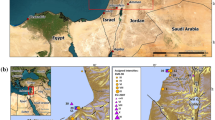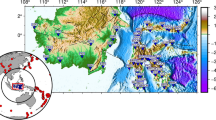Abstract
On April 20, 2013 at 8:02 am, a magnitude 7.0 earthquake occurred in Lushan County, Sichuan Province, China, which induces massive landslides, causes great losses to life and property. Based on the locations of aftershocks provided by the China Earthquake Network Center and the characteristic of Longmenshan active faults system, combined with the current preliminary focal mechanism solution, the fault rupture direction is determined. With the finite fault inversion method, we invert the rupture process of the Lushan M s7.0 earthquake by teleseismic waveforms data. The inversion results indicate that the main shock is dominated by thrust fault component and the rupture initiated at depth of 15 km, and most of slip ruptured around the hypocenter with the peak slip of about 1.5 m. Most of rupture slips released at the first 20 s and the main rupture occurred at the first 10 s after the onsets of the mainshock. Most of seismic energy released near the hypocenter with a length of 28 km, especially on both sides of the hypocenter with the range of 20 km, and the seismic energy released relatively smaller in other areas. There is a large area with weak slip between the main rupture and another two asperities on both sides of the hypocenter; it may imply that the accumulated strain on the rupture fault has not been completely released. Therefore, there is a significant possibility of having strong aftershocks in the areas where energy is not fully released. This is also the main reason why there are a lot of moderate to strong aftershocks in the Lushan aftershock sequence. In addition, there is an earthquake vacant zone with a length of about 50 km between the Wenchuan M w7.9 earthquake and this event, which is of high earthquake risk and is deserved to be paid close attention to.
Similar content being viewed by others
References
Chen G G, Ji F J, Zhou R J, et al. Primary research of activity segmentation of Longmenshan fault zone since late Quaternary (in Chinese). Seismol Geol, 2007, 29: 657–673
Gao Y, Wu Z L, Liu Z, et al. Seismic source characteristics of nine strong earthquakes from 1988 to 1990 and earthquake activity since 1970 in the Sichuan-Qinghai-Xizang (Tibet) zone of China. Pure Appl Geophys, 2000, 157: 1423–1443
Gao Y, van der Lee S, Glardini D, et al. A study on source mechanism of large Mani earthquake of 8 November 1997 in China Xizang by mode summation (in Chinese). Chin J Geophys, 2001, 44(Suppl): 98–106
Shao G F, Li X Y, Ji C, et al. Focal mechanism and slip history of the 2011 M w 9.1 off the Pacific coast of Tohoku Earthquake, constrained with teleseismic body and surface waves. Earth Planet Space, 2011, 63: 559–564
Chen L C, Wang H, Ran Y K, et al. The M s7.1 Yushu earthquake surface rupture and large historical earthquakes on the Garzê-Yushu Fault. Chin Sci Bull, 2010, 55: 3504–3509
Shan B, Xiong X, Zheng Y, et al. Stress changes on major faults caused by M w7.9 Wenchuan earthquake, May 12, 2008. Sci China Ser D-Earth Sci, 2009, 52: 593–601
Shan B, Xiong X, Zheng Y, et al. Stress changes on major faults caused by 2013 Lushan earthquake, and its relationship with 2008 Wenchuan earthquake. Sci China Earth Sci, 2013, doi: 10.1007/s11430-013-4642-1
Diao, F Q, Xiong X, Wang R J. Mechanism of transient post-seismic deformation following the 2001 M w7.8 Kunlun (China) earthquake. Pure Appl Geophys, 2011, 168: 767–779
Diao F Q, Xiong X, Wang R J, et al. Slip model of the 2008 M w7.9 Wenchuan (China) earthquake derived from the co-seismic GPS data. Earth Planet Space, 2010, 62: 869–874
Liu C L, Shan B, Zheng Y, et al. Modeling of co- and post-seismic surface deformation and gravity changes of M w6.9 Yushu, Qinghai, earthquake. Earthq Sci, 2011, 24: 177–183
Wang W M, Zhao L F, Li J, et al. Rupture process of the M s8.0 Wenchan earthquake of Sichuan, China (in Chinese). Chin J Geophy, 2008, 51: 1403–1410
Zhang Y, Xu L S, Chen Y T. Source process of the 2010 Yushu, Qinghai, earthquake. Sci China Earth Sci, 2010, 53: 1249–1251
Zheng Y, Ge C, Xie Z J, et al. Crustal and upper mantle structure and the deep seismogenic environment in the source areas of the Lushan earthquake and the Wenchuan earthquake. Sci China Earth Sci, 2013, doi: 10.1007/s11430-013-4641-2
Ji C, Wald D J, Helmberger D V. Source description of the 1999 Hector Mine, California, earthquake, part I: Wavelet domain inversion theory and resolution analysis. Bull Seismol Soc Amer, 2002, 92: 1192–1207
Olson A H, Apsel R J. Finite faults and inverse-theory with applications to the 1979 Imperial Valley earthquake. Bull Seismol Soc Amer, 1982, 72: 1969–2001
Hartzell S H, Heaton T H. Inversion of strong ground motion and teleseismic waveform data for the fault rupture history of the 1979 Imperial Valley, California earthquake. Bull Seismol Soc Amer, 1983, 73: 1553–1583
Hartzell, S, Helmberger D V. Strong-motion modeling of the Imperial Valley earthquake of 1979. Bull Seismol Soc Amer, 1982, 72: 571–596
Ji C, Wald D J, Helmberger D V. Source description of the 1999 Hector Mine, California, earthquake, part II: Complexity of slip history. Bull Seismol Soc Amer, 2002, 92: 1208–1226
Ji C, Helmberger D V, Wald D J, et al. Slip history and dynamic implications of the 1999 Chi-Chi, Taiwan, earthquake. J Geophys Res, 2003, 108: 1978–2012
Wei S J, Fielding E, Leprince S, et al. Superficial simplicity of the 2010 El Mayor-Cucapah earthquake of Baja California in Mexico. Nature Geosci, 2011, 4: 615–618
Xie Z J, Jin B K, Zheng Y, et al. Source parameters inversion of the 2013 Lushan earthquake by combining teleseismic waveforms and local seismograms. Sci China Earth Sci, 2013, doi:10.1007/s11430-013-4640-3
Bassin C, Laske G, Masters G. The current limits of resolution for surface wave tomography in North America. EOS Trans AGU, 2000, 81: 897
Shen Z K, Sun J, Zhang P, et al. Slip maxima at fault junctions and rupturing of barriers during the 2008 Wenchuan earthquake. Nature Geosci, 2009, 2: 718–724
Huang Y, Wu J P, Zhang T Z, et al. Relocation of the M 8.0 Wenchuan earthquake and its after shock sequence. Sci China Ser D-Earth Sci, 2008, 51: 1703–1711
Zheng Y, Ma H S, Lü J, et al. Source mechanism of strong aftershocks (M s⩾5.6) of the 2008/05/12 Wenchuan earthquake and the implication for seismotectonics. Sci China Ser D-Earth Sci, 2009, 52: 739–753
Lü J, Wang X S, Miao C L, et al. On characteristics of hypocenter distribution and rupture complexity of Wenchuan aftershock sequence along Longmenshan fault zone north to Beichuan (in Chinese). J Geodesy Geodyn, 2012, 32:17–21
Donald L W, Kevin J. Coppersmith. New empirical relationships among magnitude, rupture length, rupture width, rupture area, and surface displacement. Bull Seismol Soc Amer, 1994, 84: 974–1002
Author information
Authors and Affiliations
Corresponding author
Electronic supplementary material
Rights and permissions
About this article
Cite this article
Liu, C., Zheng, Y., Ge, C. et al. Rupture process of the M s7.0 Lushan earthquake, 2013. Sci. China Earth Sci. 56, 1187–1192 (2013). https://doi.org/10.1007/s11430-013-4639-9
Received:
Accepted:
Published:
Issue Date:
DOI: https://doi.org/10.1007/s11430-013-4639-9




